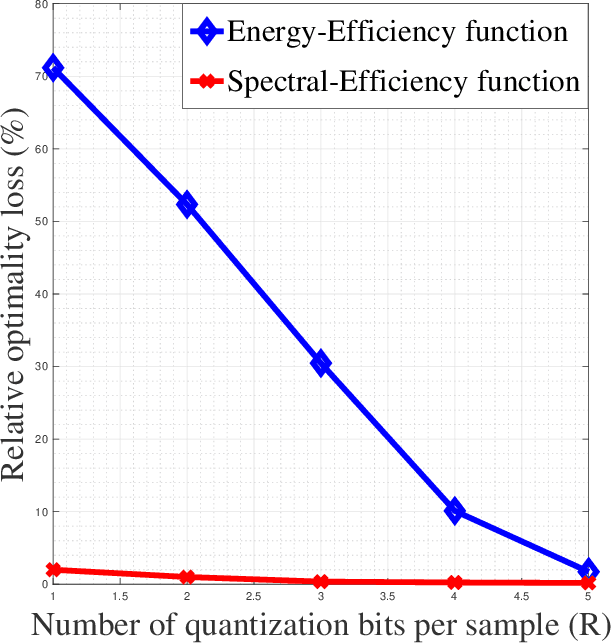Lucas Saludjian
Improving MIMO channel estimation via receive power feedback
Nov 01, 2023Abstract:Estimating the channel state is known to be an important problem in wireless networks. To this end, it matters to exploit all the available information to improve channel estimation accuracy as much as possible. It turns out that the problem of exploiting the information associated with the receive power feedback (e.g., the received signal strength indicator -RSSI-) has not been identified and solved; in this setup, the transmitter is assumed to receive feedback from all the receivers in presence. As shown in this paper, to solve this problem, classical estimation tools can be used. Using the corresponding MMSE is shown to be always beneficial, whereas the relevance of using the MAP estimator would depend on the operating SNR.
Goal-Oriented Quantization: Analysis, Design, and Application to Resource Allocation
Sep 30, 2022



Abstract:In this paper, the situation in which a receiver has to execute a task from a quantized version of the information source of interest is considered. The task is modeled by the minimization problem of a general goal function $f(x;g)$ for which the decision $x$ has to be taken from a quantized version of the parameters $g$. This problem is relevant in many applications e.g., for radio resource allocation (RA), high spectral efficiency communications, controlled systems, or data clustering in the smart grid. By resorting to high resolution (HR) analysis, it is shown how to design a quantizer that minimizes the gap between the minimum of $f$ (which would be reached by knowing $g$ perfectly) and what is effectively reached with a quantized $g$. The conducted formal analysis both provides quantization strategies in the HR regime and insights for the general regime and allows a practical algorithm to be designed. The analysis also allows one to provide some elements to the new and fundamental problem of the relationship between the goal function regularity properties and the hardness to quantize its parameters. The derived results are discussed and supported by a rich numerical performance analysis in which known RA goal functions are studied and allows one to exhibit very significant improvements by tailoring the quantization operation to the final task.
Decision-making Oriented Clustering: Application to Pricing and Power Consumption Scheduling
Jun 02, 2021



Abstract:Data clustering is an instrumental tool in the area of energy resource management. One problem with conventional clustering is that it does not take the final use of the clustered data into account, which may lead to a very suboptimal use of energy or computational resources. When clustered data are used by a decision-making entity, it turns out that significant gains can be obtained by tailoring the clustering scheme to the final task performed by the decision-making entity. The key to having good final performance is to automatically extract the important attributes of the data space that are inherently relevant to the subsequent decision-making entity, and partition the data space based on these attributes instead of partitioning the data space based on predefined conventional metrics. For this purpose, we formulate the framework of decision-making oriented clustering and propose an algorithm providing a decision-based partition of the data space and good representative decisions. By applying this novel framework and algorithm to a typical problem of real-time pricing and that of power consumption scheduling, we obtain several insightful analytical results such as the expression of the best representative price profiles for real-time pricing and a very significant reduction in terms of required clusters to perform power consumption scheduling as shown by our simulations.
* Published in Applied Energy
Decision Set Optimization and Energy-Efficient MIMO Communications
Sep 16, 2019



Abstract:Assuming that the number of possible decisions for a transmitter (e.g., the number of possible beamforming vectors) has to be finite and is given, this paper investigates for the first time the problem of determining the best decision set when energy-efficiency maximization is pursued. We propose a framework to find a good (finite) decision set which induces a minimal performance loss w.r.t. to the continuous case. We exploit this framework for a scenario of energy-efficient MIMO communications in which transmit power and beamforming vectors have to be adapted jointly to the channel given under finite-rate feedback. To determine a good decision set we propose an algorithm which combines the approach of Invasive Weed Optimization (IWO) and an Evolutionary Algorithm (EA). We provide a numerical analysis which illustrates the benefits of our point of view. In particular, given a performance loss level, the feedback rate can by reduced by 2 when the transmit decision set has been designed properly by using our algorithm. The impact on energy-efficiency is also seen to be significant.
* 7 pages, 5 figures
Decision-Oriented Communications: Application to Energy-Efficient Resource Allocation
May 17, 2019



Abstract:In this paper, we introduce the problem of decision-oriented communications, that is, the goal of the source is to send the right amount of information in order for the intended destination to execute a task. More specifically, we restrict our attention to how the source should quantize information so that the destination can maximize a utility function which represents the task to be executed only knowing the quantized information. For example, for utility functions under the form $u\left(\boldsymbol{x};\ \boldsymbol{g}\right)$, $\boldsymbol{x}$ might represent a decision in terms of using some radio resources and $\boldsymbol{g}$ the system state which is only observed through its quantized version $Q(\boldsymbol{g})$. Both in the case where the utility function is known and the case where it is only observed through its realizations, we provide solutions to determine such a quantizer. We show how this approach applies to energy-efficient power allocation. In particular, it is seen that quantizing the state very roughly is perfectly suited to sum-rate-type function maximization, whereas energy-efficiency metrics are more sensitive to imperfections.
 Add to Chrome
Add to Chrome Add to Firefox
Add to Firefox Add to Edge
Add to Edge